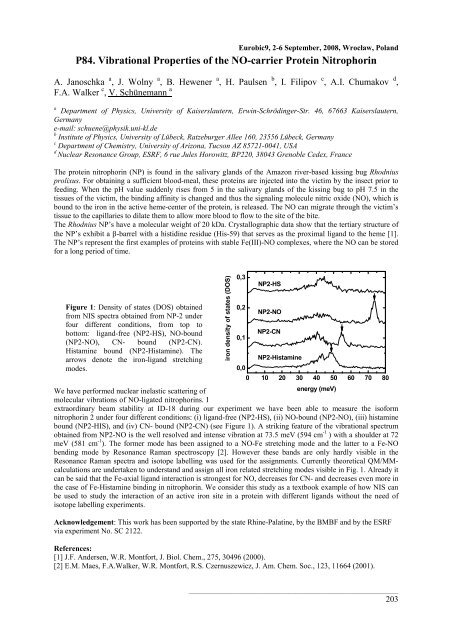ISBN: 978-83-60043-10-3 - eurobic9
ISBN: 978-83-60043-10-3 - eurobic9
ISBN: 978-83-60043-10-3 - eurobic9
You also want an ePaper? Increase the reach of your titles
YUMPU automatically turns print PDFs into web optimized ePapers that Google loves.
Eurobic9, 2-6 September, 2008, Wrocław, Poland<br />
P84. Vibrational Properties of the NO-carrier Protein Nitrophorin<br />
A. Janoschka a , J. Wolny a , B. Hewener a , H. Paulsen b , I. Filipov c , A.I. Chumakov d ,<br />
F.A. Walker c , V. Schünemann a<br />
a<br />
Department of Physics, University of Kaiserslautern, Erwin-Schrödinger-Str. 46, 67663 Kaiserslautern,<br />
Germany<br />
e-mail: schuene@physik.uni-kl.de<br />
b<br />
Institute of Physics, University of Lübeck, Ratzeburger Allee 160, 23556 Lübeck, Germany<br />
c<br />
Department of Chemistry, University of Arizona, Tucson AZ 85721-0041, USA<br />
d<br />
Nuclear Resonance Group, ESRF, 6 rue Jules Horowitz, BP220, 38043 Grenoble Cedex, France<br />
The protein nitrophorin (NP) is found in the salivary glands of the Amazon river-based kissing bug Rhodnius<br />
prolixus. For obtaining a sufficient blood-meal, these proteins are injected into the victim by the insect prior to<br />
feeding. When the pH value suddenly rises from 5 in the salivary glands of the kissing bug to pH 7.5 in the<br />
tissues of the victim, the binding affinity is changed and thus the signaling molecule nitric oxide (NO), which is<br />
bound to the iron in the active heme-center of the protein, is released. The NO can migrate through the victim’s<br />
tissue to the capillaries to dilate them to allow more blood to flow to the site of the bite.<br />
The Rhodnius NP’s have a molecular weight of 20 kDa. Crystallographic data show that the tertiary structure of<br />
the NP’s exhibit a β-barrel with a histidine residue (His-59) that serves as the proximal ligand to the heme [1].<br />
The NP’s represent the first examples of proteins with stable Fe(III)-NO complexes, where the NO can be stored<br />
for a long period of time.<br />
Figure 1: Density of states (DOS) obtained<br />
from NIS spectra obtained from NP-2 under<br />
four different conditions, from top to<br />
bottom: ligand-free (NP2-HS), NO-bound<br />
(NP2-NO), CN- bound (NP2-CN).<br />
Histamine bound (NP2-Histamine). The<br />
arrows denote the iron-ligand stretching<br />
modes.<br />
0 <strong>10</strong> 20 30 40 50 60 70 80<br />
We have performed nuclear inelastic scattering of synchroton radiation (NIS) at the ESRF to detect iron centered<br />
molecular vibrations of NO-ligated nitrophorins. Due to the high protein concentration of <strong>10</strong>mM as well as the<br />
extraordinary beam stability at ID-18 during our experiment we have been able to measure the isoform<br />
nitrophorin 2 under four different conditions: (i) ligand-free (NP2-HS), (ii) NO-bound (NP2-NO), (iii) histamine<br />
bound (NP2-HIS), and (iv) CN- bound (NP2-CN) (see Figure 1). A striking feature of the vibrational spectrum<br />
obtained from NP2-NO is the well resolved and intense vibration at 73.5 meV (594 cm -1 ) with a shoulder at 72<br />
meV (581 cm -1 energy (meV)<br />
). The former mode has been assigned to a NO-Fe stretching mode and the latter to a Fe-NO<br />
bending mode by Resonance Raman spectroscopy [2]. However these bands are only hardly visible in the<br />
Resonance Raman spectra and isotope labelling was used for the assignments. Currently theoretical QM/MMcalculations<br />
are undertaken to understand and assign all iron related stretching modes visible in Fig. 1. Already it<br />
can be said that the Fe-axial ligand interaction is strongest for NO, decreases for CN- and decreases even more in<br />
the case of Fe-Histamine binding in nitrophorin. We consider this study as a textbook example of how NIS can<br />
be used to study the interaction of an active iron site in a protein with different ligands without the need of<br />
isotope labelling experiments.<br />
Acknowledgement: This work has been supported by the state Rhine-Palatine, by the BMBF and by the ESRF<br />
via experiment No. SC 2122.<br />
References:<br />
[1] J.F. Andersen, W.R. Montfort, J. Biol. Chem., 275, 30496 (2000).<br />
[2] E.M. Maes, F.A.Walker, W.R. Montfort, R.S. Czernuszewicz, J. Am. Chem. Soc., 123, 11664 (2001).<br />
iron density of states (DOS)<br />
0,3<br />
0,2<br />
0,1<br />
0,0<br />
NP2-HS<br />
NP2-NO<br />
NP2-CN<br />
NP2-Histamine<br />
_____________________________________________________________________<br />
203


